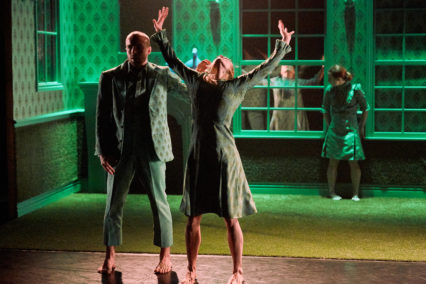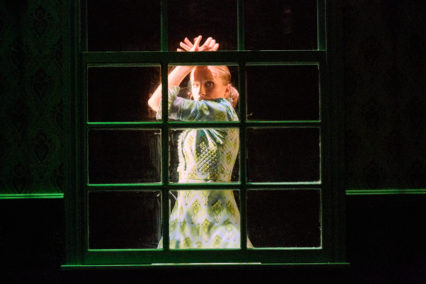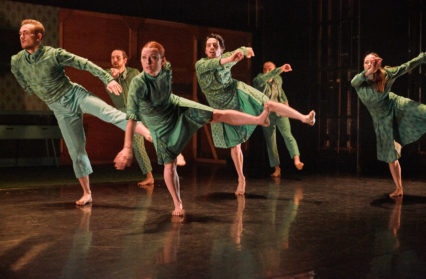This double bill from National Dance Company Wales raises as many questions as it does set affirmations, but one thing that cannot be avoided is that in their Artistic Director (and creator of tonight’s Green House) Caroline Finn they have a world-class creative talent, one who has a singular intellectual vision that is able to meld choreography with artistic vision and produce a corporeal statement of remarkable power. It is one thing to have the vision to invite, nurture and stage a mercurial talent such as that of Israel’s Roy Assaf, whose Profundis forms an exhilarating and playful first half, but it is quite another to conceive and mount a show like Green House.

Firstly, Profundis is an exceptionally enjoyable piece of work, a sharp and witty exploration of the meaning of art and communication, danced first to Umm Kulthum’s “Enta Omri” and then to an hypnotic electronic soundscape. It is colourful, funny, and is clearly not afraid to lay out exactly what it is getting at; Assaf is as comfortable shouting in your face as he is with his laidback version of ambiguity. At one point, Leonard Bernstein lectures on the meaninglessness of music as symbol – a provocatively ironic goading of an audience that has just been drenched in the richness of the ensemble piece in front of them. It is coolly lit, and unless you count minimalism as an affectation (which Profundis may well be asking you to do) then it is also a set without props, a staging without pretension. The dancers make their way through an array of representations of the questions posed – much of the colour comes from the energy on stage and it is here that we are also allowed to see some of the individual personalities of this excellent company.
But in the end, Profundis may be a little too glutinous in the cake-and-eating-it department. Assaf invites the audience to second-guess every inch of the staging, every nanosecond of sound. How long before questioning everything becomes questioning nothing? Perhaps this is the point. Hats off to Mr Assaf for that grinning spiral of futility.
Green House maintains the sense of humour of Profundis, even exploits the notion of spirals, but it only takes a few moments to realise that this is the main attraction, the real heavyweight piece.
The stage is set, a house interior, bedecked in 1950s domestic kelly green, and the opening music is Percy Faith’s version of “Theme from A Summer Place” – the archetypal soundtrack to 1950’s soapsud suburbia. The players begin their own disjointed journeys, played on loop, and the patterns lead through a maze of emotive and often funny set pieces. But this “classic sitcom” pretence leads us to some much darker places. Dancers step forward for solos, and there is very little lightness or humour here.
 Camille Giraudeau gives perhaps the most hauntingly tragic performance of the evening here in a startling evocation of the volcanic frustrations of suburban detachment. It is the most striking and memorable sets in an evening of high marks, a cacophonous outpouring that emotionally moves far beyond the physical extremities of Giraudeau herself; the auditorium seems to become an extension of the frustrated energy, the and the green house becomes in danger of enveloping us all. In Giraudeau’s piece we have perhaps a defining characteristic of twentieth century western existence – that as the world shrinks loneliness becomes more intensely felt. Matteo Marfoglia’s solo, likewise, although a little rougher around the edges, lands with a crushing sense of the futility of life within those four walls. Elena Thomas and Franklyn Lee’s duet is a rhythmic delight, mixing a strong tension and palpable sadness with the occasional gaudy fling of lindy hop.
Camille Giraudeau gives perhaps the most hauntingly tragic performance of the evening here in a startling evocation of the volcanic frustrations of suburban detachment. It is the most striking and memorable sets in an evening of high marks, a cacophonous outpouring that emotionally moves far beyond the physical extremities of Giraudeau herself; the auditorium seems to become an extension of the frustrated energy, the and the green house becomes in danger of enveloping us all. In Giraudeau’s piece we have perhaps a defining characteristic of twentieth century western existence – that as the world shrinks loneliness becomes more intensely felt. Matteo Marfoglia’s solo, likewise, although a little rougher around the edges, lands with a crushing sense of the futility of life within those four walls. Elena Thomas and Franklyn Lee’s duet is a rhythmic delight, mixing a strong tension and palpable sadness with the occasional gaudy fling of lindy hop.

But if Green House belongs to any one person on stage it is Àngela Boix Duran, who scouts the exterior of the house, committing most of her performance through a window. It is no small thing to create such a moving vision in such a restricted physical space. Boix Duran has to convey the frustration of the exile, the anger of the outsider, almost entirely from within the frame, and she is simply excellent.
This is a strange Beckettian version of the middle class utopia that was the middle part of the twentieth century and was, we can now see, the pinnacle of the Capitalist experiment. The century had built up to it, and ever since society has been disintegrating off its back. Much can be concluded from the symbolism of walls, windows, ladders, the trappings of suburbia, the implication of this suburban fishbowl as botanical hothouse, but at the centre of it is human struggle, sadness and loneliness, personified by the scintillating performances of the dancers. Green House is about people.
That said, no student of that century can be subjected to the thundering loop of a steam locomotive without thinking of Steve Reich’s Different Trains, or even that lingering Treblinka segment of Claude Lanzmann’s Shoah. The tumultuous dancing that accompanies this section is some of the most discomforting and moving ensemble work you are likely to see anywhere. And later, with five of the dancers positioned at the window as if posing for a family portrait, the pairing with Rachmaninov cannot help but bring to mind the murder of the Romanovs. Finn says her work is not political, but this just doesn’t wash. It is political in the truest sense – everything this sincere is political. At work here is an astute creative mind that clearly understands the symbolic potential of the images she creates.
And in National Dance Company Wales Finn may just have been given a collection of dancers utterly receptive to her gifts. Green House confirms Finn is one of the most brilliant artists working in Wales today across any medium you care to mention, and is exactly the kind of figure to turn the attention of the dance world toward our humble shores.
Profundis / Green House was reviewed at Theatr Brycheiniog in Brecon. For information on the tour visit here.



 Enjoyed this article? Support our writers directly by buying them a coffee and clicking this link.
Enjoyed this article? Support our writers directly by buying them a coffee and clicking this link.








